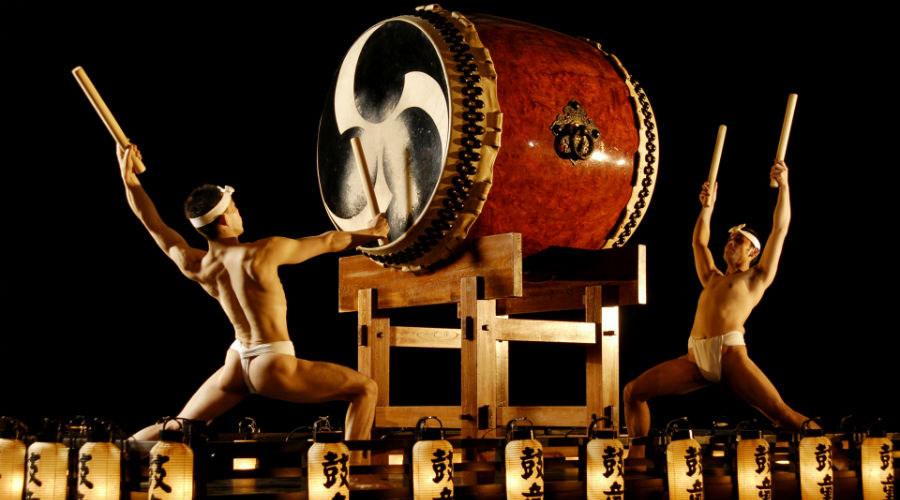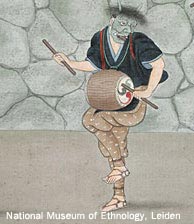Instruments
Drums
There are many large Japanese drums, or taiko. Most have two membranes which are nailed or laced and are struck with sticks. The most dramatic is the Odaiko (big drum). The physical energy and sheer excitement of an Odaiko performance is an integral part of many Japanese matsuri (festivals). Perhaps because they see this all the time, most Japanese people don’t get particularly excited by taiko performance groups like Kodo, while foreign audiences are enthralled by them. Each year, Kodo host Earth Celebration, a festival of taiko drumming, international music and performance art in their home base on Sado Island. Many people come to Japan from around the world to enjoy the festival and it is certainly a highlight of the Japanese cultural calendar. Kodo also tour extensively abroad every year.
The hourglass-shaped tsuzumi was introduced from the Asian continent around the 7th century and the name is derived from Sanskrit. Two varieties, the smaller kotsuzumi and the larger otsuzumi are used in both noh and kabuki performances. The kotsuzumi is held on the right shoulder and the player alters the tone by squeezing the laces. The otsuzumi is held on the left thigh. Like all other traditional arts in Japan, there are several schools of tsuzumi.
http://www.taiko.com/taiko_resource/history.html
Stringed Instruments
The koto is a 13-string zither, about 2 meters long and made of Paulownia wood. It is plucked using picks on the thumb and first two fingers of the right hand, while the left hand can be used to modify pitch and tone. Koto are used in an ensemble in gagaku or as a solo instrument. One of the most famous koto players and composers was the blind musician Miyagi Michio (1894-1956), who was heavily influenced by western music.
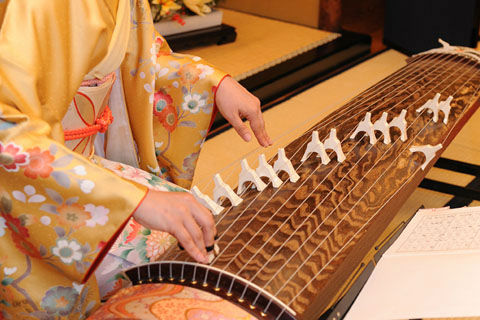
A closeup of a koto player
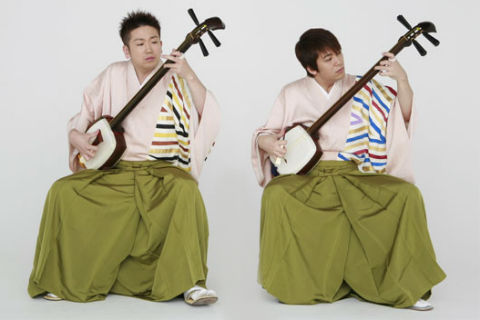
The Yoshida Brothers have brought a rock sensibility to the shamisen
The shamisen is a 3-string lute. It is believed to be a variant of the Okinawan sanshin. The length of the shamisen varies from 1.1 to 1.4 meters. It first became popular in the pleasure districts during the Edo Period (1600-1868) and also began to be used for the musical accompaniment in kabuki and bunraku performances. The kabuki variety developed into its own form of dance music, the nagauta or long song. Shamisen are made from one of a variety of woods such as red sandalwood and the head covered with cat or dog skin. The pegs are traditionally made of ivory while the strings are twisted silk.
Traditional shamisen playing requires the player to be quite stiff and expressionless. But young players like the Yoshida Brothers or Agatsuma Hiromitsu bring a whole new, some would say rock and roll, approach that gets young fans in a frenzy of excitement while putting their elders in a fit of anger.
The biwa is a short-necked lute, used from the 7th century in gagaku to accompany early puppet plays and also by blind monk entertainers, the Japanese equivalent of traveling minstrels. The main character in one of Japan’s most famous legends, The Story of Earless Hoichi was one of these biwa hoshi (lute priests). There are many styles, the most popular being Satsuma biwa which was developed in the 16th century. The number of frets varies from 4 to 6 and strings vary in number from 3 to 5 but there are usually 4. The biwa is held almost vertical and played with a large bachi (plectrum).
Flutes
The most famous flute is the shakuhachi bamboo flute. It has 4 or 5 finger holes on the front face and a thumb hole on the rear face. As with other instruments above, it was imported from China for gagaku. In medieval times, the shakuhachi became associated with wandering Buddhist priests known as komuso or ‘priests of nothingness’. They played the shakuhachi as a spiritual discipline and during the Edo Period they had the exclusive license to play the instrument. They are easily recognized by their straw inverted basket-like headgear. During the more progressive Meiji Period (1868-1912) various other shakuhachi schools started, some influenced by western music.
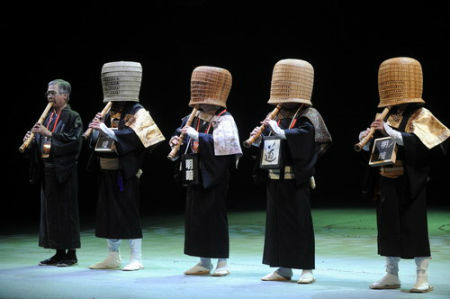
A group of shakuhachi players dressed as komuso
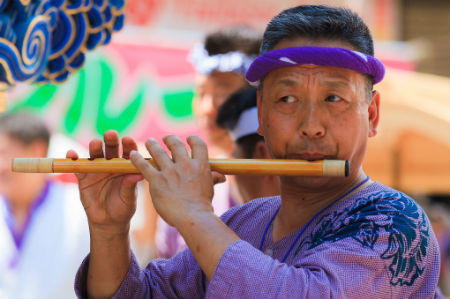
A flute player at a local festival
Other flutes include the nokan used in noh performances and the side-blown takebue and shinobue often heard during festivals. Kodo often incorporate flute pieces into their repertoire.
http://www.pbs.org/empires/japan/instruments.html
Learn about these instruments below and play samples.
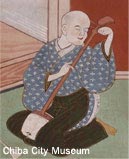
Shamisen
A banjo-like lute with three strings, the shamisen was brought to Japan from China in the 16th century. Popular in Edo’s pleasure districts, the shamisen was often used in Kabuki theater. Made from red sandalwood and ranging from 4.5 feet long, the shamisen has ivory pegs, strings made from twisted silk, and a belly covered in cat or dog skin. The strings, which are of different thickness, are plucked or struck with a tortoise shell pick.
Koto
Made from Paulownia wood, the harp-like koto was brought to Japan from China in the 6th century. While early kotos had 5 strings, it now typically has 13 strings made from nylon or silk of the same thickness. Tuned in a pentatonic scale, the strings are stretched tightly over bridges along the length of the instrument which can be moved to change the pitch. Often studied by girls in samurai families, the koto was played as an ensemble or solo instrument.
Shakuhachi
Made from the lowest section of bamboo, the shakuhachi is an end-blown flute with four front holes and one in back. Generally 1.8 Japanese feet in length, the shakuhachi is named for its dimensions—”shaku” means “foot,” and “hachi” means “eight.” Originally imported from China, the shakuhachi became the province of Buddhist priests during the Edo period, who alone were permitted to play the instrument.
Tsutsumi
Often used in traditional Japanese theater, the tsuzumi drum (alternatively spelled “tsuzumi”) has two drumheads supported by tension cords which, when pulled, alter the pitch. Using the right hand to strike the drum, the tsutsumi player uses the left hand to hold the drum to the right shoulder.
Taiko
Meaning “big drum” or “fat drum,” taiko encompasses a family of drums that range from the small to the gigantic, whose precursors were designed by Japanese craftsmen more than a thousand years ago. Made from cowhide and generally struck with a stick called bachi, large taiko drums are positioned on stands, with more than one musician often playing. Taiko drums were reputedly played on the battlefield, their rich, rumbling sounds used to intimidate the enemy. During the last 50 years, taiko-style drumming has become immensely popular in Japan, spawning over 8,000 groups.
MUSIC CREDIT:
Dave Iwataki
IMAGE CREDITS:
Shakuhachi courtesy of Monty Levensen; Shamisen and Koto courtesy of Reiko Abata; Taiko courtesy of Mochizuki Taiko; Tsuzmi courtesy of Shigeo Ando


